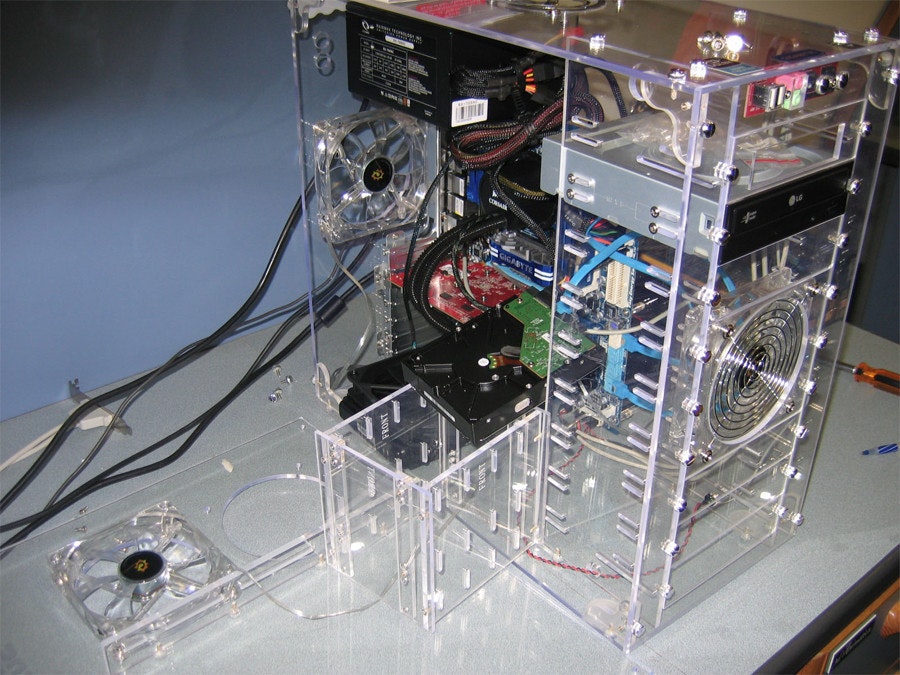Technology is great, but it can also be overwhelming. What’s the best computer for graphic design? Mac or PC? What other equipment do you need? Where do you even begin?
Hardware
—

Virtually any computer more powerful than a netbook, and less than three years old, will probably serve your basic needs. Everyone does a little photo editing here and there, even if it’s just adding a sepia tone to your baby’s pictures.
But once you’ve committed to becoming a serious graphic designer, you’ll almost certainly want to upgrade your computer. The best computer for graphic design will vary from designer to designer, but there are some key things to focus on: processor speed, memory, screen resolution and, something you might not have heard of, hard disk speed.
Graphic design software is processor-intensive, and it only becomes moreso every year. For most programs, you’ll want a processor (or “CPU”) that runs at least 1Ghz (meaning the computer can make one billion calculations per second). That’s the minimum; look for an even faster processor if you can afford it. But there’s more to computer speed than just the processor.
There’s also Random Access Memory, or “RAM,” or sometimes just “memory.” (Not to be confused with storage memory. Easy, right?) RAM is kind of like short-term memory; it’s the stuff that your computer keeps at the forefront of its mind. The more RAM you have, the more things you can process at once, because it’s faster than going to the hard drive for the files in use. You’ll want, at minimum, 8Gb of RAM; more if you can afford it. (You’ll find “more if you can afford it” is a pattern.)
Once you’ve passed these minimums, you might wonder where to spend your money on speeding up your computer even more. The fact is, once your CPU is past the gigahertz range, you’re unlikely to notice a performance increase by getting a faster processor. Your money would be much better spent on RAM. 16 or even 32 gigs will definitely make your work fly by.
Any sort of off-the-shelf computer you’d be considering is likely to have a fairly large hard drive. You shouldn’t really be concerned about that, though, because the built-in hard drive should primarily be used for installing software and storing projects you’re currently working on. Old design files, that you only have to access occasionally, can and should be stored on external drives, which brings us to…
Peripherals
—

Hard drive
There are two types of hard drives: Hard Disk Drives (HDD) and Solid State Drives (SSD). On the inside, HDDs are metal disks with magnetic coating. They physically spin, similar to record players, only at much higher speeds. SSDs are made up of a series of memory chips, and thus have no moving parts.
There are advantages and disadvantages to both. HDDs are cheaper, usually about half the price for the same amount of storage. In fact, HDDs have a higher ceiling for total storage; SSDs tend to top out around 4 terabytes. On the other hand, SSDs are more durable, because they don’t have moving parts. You can drop an SSD off your desk onto the floor, and it’ll probably be fine; that’s not the case with an HDD. If you’re going to be moving around a lot while working, SSDs are the way to go.
But the real advantage of SSDs is their speed. If your internal hard drive is an SSD, you’ll notice your computer boots faster, and programs launch faster. For your external drive, data transfers more quickly from SSDs than HDDs.
If you decide to go with an HDD, the hard disk speed is something to pay attention to. The hard drive on which you install the software should spin at 7200rpm. This speed is less important for your external storage; as long as you’re only storing files and not actually running software on the external hard drive, 5400rpm is fine.
As for storage space itself, a 1TB hard drive is a good place to start, and 2TB wouldn’t hurt. You’ll be constantly expanding your storage space, but according to Moore’s Law, it’ll get cheaper every year, so don’t spend all your money now.
Monitor
For your monitor, ensure the resolution is at least 1280 x 800. Again, higher resolution is better, if you can afford it. If you plan on purchasing a laptop for portability, you may be limited in your choices, but anything less than 1280 X 800 may not even run the graphic design program of your choice.
Most monitors on the market are TN (Twisted Nematic) panels. They’re very common, because they’re very cheap. Unfortunately, they’re cheap because their color reproduction isn’t great. A graphic design would be better served purchasing a VA (Vertical Alignment) Panel or IPS (In-Plane Switching) monitor. IPS are the most expensive of the three options, but their price is definitely worth it.
And what about Retina? While this is technically an Apple-only term, it is the Kleenex to high pixel density display’s tissue. Retina (and other high pixel density) displays are intended to make images and text appear extremely sharp. Traditionally, computer monitors have a resolution for 72 Pixels per inch (PPI), meaning each inch of your display is made up of 5, 184 little squares (72×72). Retina displays have a resolution of… more than that. Even Apple isn’t consistent—their retina products range from a resolution of 218-401 PPI. So, like with everything, this falls into the “more if you can afford it” category. Though I suspect in the next couple years high pixel density monitors will become the norm, so if you’re investing for the long term it’s probably worth it.
Check out our post on how to choose the perfect monitor for you.

Graphics tablet
If you’re reading this blog post, you’re probably familiar with your computer’s mouse and/or trackpad. These are great for every day use, but key tool in most graphic designers’ toolboxes is the graphics tablet. There’s a reason why humans have been using pens and paper for at least 5,000 years.
Graphics tablets bring that natural hand-eye connection to the digital age. They range in price from around $50 to $500. While Wacom is generally recognized as the industry leader, this is really a try-before-you-buy situation. You need to physically hold the stylus in your hand, rest your palm on the tablet, try out the feel. Otherwise, you might waste several hundred dollars on a tablet that cramps your hand after 15 minutes.
Not that that ever happened to me…
Mac vs. PC – the eternal debate
—
You’ve probably heard that Macs are built for free-spirited artists, and PCs are more suited for office drones. You might also note that this impression was created by an ad campaign from a company that stands to profit from this image.

The fact is, there was a time when it was true that Apple had pretty much cornered the market on graphic design computers. Digital typography was born on a Mac. Photoshop was built for Macs.
Apple was the only game in town for decades, which is why older more experienced graphic designers view it as the only real option. It’s the system they learned and excelled at, and they’re not about to change.
But today, this is nothing more than an outdated bias. Most graphic design software runs equally well on Windows and OS X. Windows PCs are much more affordable and more customizable. Plus, outside of creative industries like design and film, most companies prefer Windows; it might be helpful if your operating system was compatible with your clients’.
That being said, the most important factor in choosing a Mac or a PC is, what are you comfortable with? Do you like the look and feel of a Mac? Do you know all the Windows shortcuts by heart? Do you want to do anything else (i.e. play games, produce videos) with your computer? What can you afford (Macs are almost always more expensive)?
In the end, don’t worry about which computer seems “cool.” Choose the one that feels right to you.
Still, that 1984 ad is pretty sweet…
There’s more to design than the tools
—

These days, just about anybody can call themselves a graphic designer. You could download the above tools in a matter of minutes, and get started in less time than it took me to write this post.
That ease of access means there’s a lot of competition out there. To stand out as a graphic designer, you’ll need more than a high-end computer and fancy software. You’ll need raw talent, education, dedication, and lots and lots of practice. Now that you have the tools, it’s all up to you.
Source: https://99designs.ca/blog/tips/best-computer-graphic-design/






